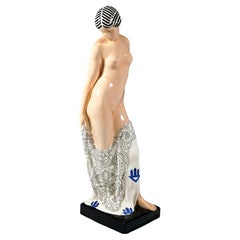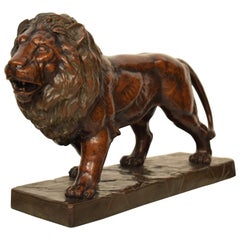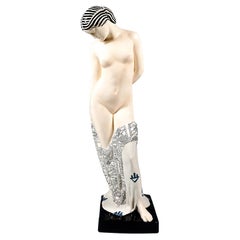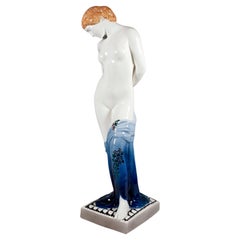Ernst Seger Furniture
to
1
1
2
1
1
2
2
2
1
1
1
2
1
1
2
2
2
1
7,546
3,967
2,548
2,244
Creator: Ernst Seger
Ernst Seger, David and Lion, German Art Deco Patinated Bronze Sculpture, c. 1920
By Ernst Seger
Located in New York, NY
Signed “E. Seger”.
Black patina.
Dimensions
Height: 8 inches (20cm)
Width: 7.5 inches (18.75cm)
Depth: 8.5 inches (21.25cm)
THE BIBLE STORY
Samuel 17:34-36
Originally, Saul would not allow David to fight Goliath (17:33). Saul’s reason was simply that Goliath would be stronger than David. David was young and he did not have the experience to fight such a capable enemy as Goliath. David was likely to die, and his death would benefit nobody.
Often people wrongly imagine that they are acting in faith (in other words, that they are trusting God). Really, they are acting in a foolish manner, as if the danger is not real. They are not trusting in God, but in their own thoughts, hopes and desires.
David’s reply to Saul shows us his attitudes. This reply explains clearly why David had offered to fight Goliath. In other words, it shows how David considered himself able to defeat Goliath.
Like many boys and young men in Israel, David had worked as a shepherd. That is, he looked after sheep. He was responsible to look after those sheep in every way. In particular, he had to protect them from wild animals.
Lions and bears are some of the fiercest large wild animals. They were common in Israel at the time of the Bible. They are much stronger than a man (see for example 1 Kings 13:24 and 2 Kings 2:24). Only the bravest and strongest men were able to kill a lion (Judges 14:5-6; 2 Samuel 23:20). However, David had killed both a lion and a bear. He had killed animals that were stronger than him.
David did not believe that the strongest man would win the fight. David had a close relationship with God; he was trusting God to rescue him (17:37). David was not pretending that there was no danger. However, God’s Holy Spirit was active in David’s life (16:13). By the power of his Holy Spirit, God had given David the faith (trust in God) to fight Goliath. Because David really was trusting God, there was no reason for him to be afraid of Goliath.
THE ARTIST
Ernst Seger (1865 1939), born in Neurode (Nowa Ruda, now Poland), studied sculpturing from 1884 at the Kunstschule in Breslau under Robert Härtel. From 1886 he worked in the Atelier of Christian Behrens, where he created the Eichendorff-Memorial for the Silezian City of Neisse. From 1893 to 1894 Seger stayed in Paris where he worked in the atelier of Auguste Rodin. However, Seger finally chose a ‘Jugenstill’ and a more ‘naturalistic’ or ‘Neuklassizismus’ style. His sculptures, modelled like the Greek antiques, were later greatly admired by the National Socialists.
At the end of 1894 Ernst Seger went back to Berlin, founded his own atelier and created the Kaiser Wilhelm I memorial for the Silesian City of Glatz. In 1897 Seger created the sculpture ‘Jugend’ (‘Youth’), which was displayed at the ‘Große Berliner Kunstausstellung’ in 1898, at the ‘Große Berliner Kunstausstellung’ in 1899, at the ‘Münchener Glaspalast Ausstellung’ in 1899 and at the ‘Münchener Glaspalast Ausstellung’ in 1908. As a sculptor Seger regarded this as his first relevant work, his breakthrough. A copy of the sculpture in bronze, 1.60 metres high, was placed in the ‘Scheitniger Park’ in Breslau (now Wroclaw). In 1898 Segers ‘Diana’, the Roman Goddess of the Hunt, the Moon and Childbirth, was unvealed in Park Szczytnicki, Breslau, Polen (earlier ‘Schneitniger Park’). Until 1945 the sculpture stayed in the Schneitniger Park, Breslau. This part of the park is still called ’Dianagarten’.
After the turn of the century the elegant female dancers and nudes by Seger gained great popularity. In 1905 Ernst Seger created -together with the sculptor Bernhard Sehring- the ‘Bismarck Brunnen’ (‘Bismarck Fountain’) in Breslau. This memorial-fountain (which still exists) represents the allegories ‘Kampf’ and ‘Sieg’ (‘Battle and Victory’). Seger’s ‘Verwundete Amazone’ (‘Wounded Amazon’), displayed at the Grosse Münchner Kunstausstellung in the Glaspalast in 1908, was placed in the garden of the ‘Kaufhauses Wertheim’ in Berlin. In the same year he was appointed as a professor. Seger’s marble sculpture ‘Kypris’, created in 1916, was placed in the Alten Nationalgalerie in Berlin. In 1925 the City of Berlin acquired his sculpture ‘Anbetung’ and placed it at the Johannaplatz. ‘Storchenbrunnen’ (‘Stork-fountain’), was placed in 1931 at the Adolf-Scheidt-Platz in Berlin. In 1935 the American newspaper publisher William Randolph Hearst bought Seger’s sleeping ‘Ganymede’.
During the Third Reich Ernst Seger was commissioned numerous Hitler busts...
Category
1920s German Art Deco Vintage Ernst Seger Furniture
Materials
Bronze
Large Goldscheider Art Déco Figurine 'Helena', Allegory of Beauty, circa 1925
By Goldscheider Manufactory of Vienna, Ernst Seger
Located in Vienna, AT
Very large and rare Goldscheider Vienna ceramic figurine:
Art Déco execution of an Art Nouveau design around 1909: young woman as the personification of beauty, with hair tied at th...
Category
1920s Austrian Art Nouveau Vintage Ernst Seger Furniture
Materials
Ceramic
Related Items
Big German Art Deco Lion Sculpture in Ceramic, Terracotta Copper, 1930
Located in Berlin, DE
This very fine German Art Deco lion sculpture in ceramic, terracotta and a copper finish was made in the 1930s by EJM.
It is in a perfect antique condition with no chips and beautif...
Category
1930s German Art Deco Vintage Ernst Seger Furniture
Materials
Copper
H 13.39 in W 21.66 in D 6.3 in
French Art Deco Ceramic Tigers, 1920
By ODYV
Located in Saint-Amans-des-Cots, FR
French Art Deco ceramic sculpture by Odette Berlot & Yvonne Mussier, France, 1920s. Three tigers. Measures: height: 8.3"(21cm), width : 20.5"(52cm), depth: 3.9"(10cm). Marked "Odyv 1...
Category
1920s French Art Deco Vintage Ernst Seger Furniture
Materials
Ceramic
Van Briggle Art Deco Celadon Glazed North American Native Figurine
By Van Briggle
Located in Bishop's Stortford, Hertfordshire
A very fine Art Deco pottery figure of a North American Native figure of a kneeling girl made by Van Briggle Art Pottery in the 1930’s. Van Briggle Art p...
Category
1930s American Art Deco Vintage Ernst Seger Furniture
Materials
Pottery
French Art Deco Ceramic Bust of a Young Faun
Located in Winter Park, FL
A French Art Deco craquelé ceramic bust of a young faun with pointed ears and a garland of leaves on his head. Marble base. Weight: 4.5 lbs. Please refer to photos for more details. ...
Category
20th Century French Art Deco Ernst Seger Furniture
Materials
Marble
Art Deco Ceramic Glazed Dancer Sculpture by Goldscheider, Vienna, 1930s
By Friedrich Goldscheider
Located in Ulm, DE
Beautiful Goldscheider Dancer Sculpture
Very detailed glazed ceramic sculpture in great condition!
Original Art Deco, Vienna (Austria) 1930s
Di...
Category
Early 20th Century Austrian Art Deco Ernst Seger Furniture
Materials
Ceramic
H 11.42 in W 5.91 in D 4.34 in
Bronze Figurine Sculpture Hoop Dancer After D H Chiparus, Art Deco Circa 1920s
By Demetre Chiparus
Located in Lincoln, Lincolnshire
This is a solid bronze figurine of a dancing lady called Hoop Girl after D H Chiparus, on an Onyx base, dating to the Art Deco period, Circa 1925 to 1935.
...
Category
1920s French Art Deco Vintage Ernst Seger Furniture
Materials
Onyx, Bronze
H 11.38 in W 6 in D 3.38 in
Life-Size Art Deco Patinated Bronze Greyhound Sculpture
Located in Forney, TX
A life size Art Deco patinated bronze figural dog sculpture, most likely Italian, early/mid-20th century.
Fine quality, exceptionally execute...
Category
Early 20th Century Art Deco Ernst Seger Furniture
Materials
Bronze
Art Deco Statue Pheasant Sculpture Gilded Bronze Marble 1920s
Located in Poperinge, BE
Art deco statuette, sculpture of a pheasant made of bronze gilded with gold leaf, completely in the typical art deco style, mounted on a rounded red marble base, at the bottom a name...
Category
Early 20th Century Belgian Art Deco Ernst Seger Furniture
Materials
Marble, Bronze, Gold Leaf
Paul Milet for Sevres, France, Large Art Deco Fox in Glazed Ceramics
Located in Copenhagen, DK
Paul Milet for Sevres, France. Large Art Deco fox in glazed ceramics. Beautiful red glaze.
1920's.
Marked.
In perfect condition.
Measurimg L 57 x H 18...
Category
1920s French Art Deco Vintage Ernst Seger Furniture
Materials
Ceramic
Rare Pair of Lladro Chinese Farmer Porcelain Figurines
By Lladro
Located in Dallas, TX
PRESENTING a GORGEOUS PAIR of extremely rare and important Lladro, long retired porcelain figurine sculptures.
Known as the ‘Chinese Farmer’ and the ‘Chinese Farmer with Staff’.
Th...
Category
Late 20th Century Spanish Mid-Century Modern Ernst Seger Furniture
Materials
Porcelain
Lladró Porcelain Figurine of a Group of Birds Dated from 1978
Located in Marbella, ES
Lladró Porcelain Figurine of a group of birds dated from 1978.
Category
Late 20th Century Spanish Ernst Seger Furniture
Materials
Porcelain
Plaster Sculpture Bronze Patinated Abstract Art
Located in Saarbruecken, DE
Handmade plaster figure with patinated bronze on a wooden base. The sculpture is by the German artist TADÄUS from the series formless body shapes from 2002. A very decorative individ...
Category
21st Century and Contemporary German Organic Modern Ernst Seger Furniture
Materials
Plaster
Previously Available Items
Large Goldscheider Art Déco Figurine 'Helena', Allegory of Beauty, circa 1920
By Goldscheider Manufactory of Vienna, Ernst Seger
Located in Vienna, AT
Very large and rare Goldscheider Vienna ceramic figurine:
Art Déco execution of an Art Nouveau design around 1909: young woman as the personification of beauty, with hair tied at the nape of the neck, head tilted to the side and looking down, covering the nakedness of her shapely body only at the legs with a large cloth...
Category
1920s Austrian Art Nouveau Vintage Ernst Seger Furniture
Materials
Ceramic
H 22.05 in W 7.09 in D 6.7 in
Large Goldscheider Art Déco Figurine 'Helena', Allegory of Beauty, circa 1920
By Goldscheider Manufactory of Vienna, Ernst Seger
Located in Vienna, AT
Very large and rare Goldscheider Vienna ceramic figurine:
Art Déco execution of an Art Nouveau design around 1909: young woman as the personification of beauty, with hair tied at th...
Category
1920s Austrian Art Nouveau Vintage Ernst Seger Furniture
Materials
Ceramic
H 22.05 in W 6.7 in D 6.7 in
Antique Alabaster & Marble Figural Table Lamp Ernst Seger, 1920s
By Ernst Seger
Located in London, GB
This is a beautiful museum quality antique Art Deco carved alabaster and marble figural table lamp, by the German sculptor Ernst Seger (1868-1939) the base bearing his engraved signa...
Category
1920s German Art Deco Vintage Ernst Seger Furniture
Materials
Alabaster, Marble
Ernst Seger, Girl Nude with Hair Band, c.1915-1925
By Ernst Seger
Located in Kingston, NY
Ernst Seger, (Madchenakt mit Haarband) Girl nude with hair band. Circa 1915-1925. Measures 20"H x 9.5"D x 14"W. The orange marble base is additional...
Category
Early 20th Century German Ernst Seger Furniture
Materials
Marble
Ernst Seger furniture for sale on 1stDibs.
Ernst Seger furniture are available for sale on 1stDibs. These distinctive items are frequently made of ceramic and are designed with extraordinary care. There are many options to choose from in our collection of Ernst Seger furniture, although beige editions of this piece are particularly popular. Many of the original furniture by Ernst Seger were created in the Art Nouveau style in europe during the 1920s. If you’re looking for additional options, many customers also consider furniture by Antal Bachruch, Josef Carl Klinkosch, and Bernhard Hoetger. Prices for Ernst Seger furniture can differ depending upon size, time period and other attributes — on 1stDibs, these items begin at $5,800 and can go as high as $8,661, while a piece like these, on average, fetch $8,650.





